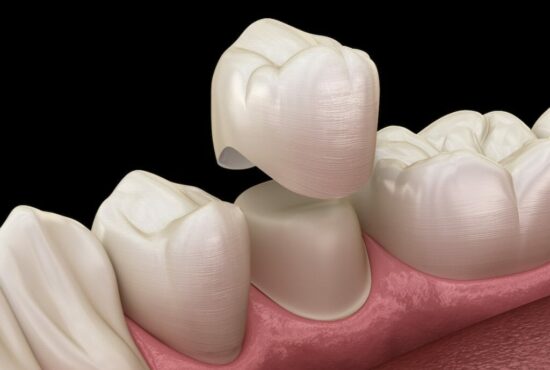Crowns for teeth
Best Dental Crown Treatment in Hadapsar, Pune, kharadi at Dentaverse Clinic.
A crown is mostly used to restore a tooth that has been damaged. For example, if a large cavity threatens the health of a tooth, then it is better to restore it using a crown instead of fixing the cavity directly. This way of treatment is considered more conservative and lacks side effects that are commonly incurred in treating cavities.
Procedure
The multi-day procedure with a brief crown
With a conventional crown, you’ll get to visit your dentist’s workplace double.
- The dental practitioner examines and prepares the tooth that desires the crown. This may involve taking X-rays of the tooth. They conjointly could take a mold of your tooth or mouth beforehand.
- Your dental practitioner can file down and take away a part of the outer layer of the tooth.
- a sway is manufactured from your cut tooth and therefore the encompassing teeth.
- The dental practitioner can place a brief crown over your tooth to shield it.
- They send the impression to a science lab that produces the crown. This step could take many weeks.
- once the crown comes in, you’ll come for the second visit, thus your dental practitioner will cement the crown to your tooth.
Once the crown is in, it’s necessary to require excellent care of it. Careful attention to your crown will prolong its life.
Here are some useful tips:
- Practice careful brushing. If you’re not already brushing your teeth double daily, it’s time to start. think about employing dentifrice for sensitive teeth if your crown or the teeth around it are sensitive to heat or cold.
- Flossing daily will facilitate keeping all of your teeth in tip-top form.
- Avoid arduous foods. manduction ice or arduous foods may cause your crown to crack, particularly if you have got a ceramic ware crown.
- If you grind or clench your teeth in the hours of darkness, your dental practitioner could advocate an evening guard to shield your crown and encompassing teeth.
How long do dental crowns last?
The life of a crown will vary between five and fifteen years. Some crowns are sturdier than others so they could last longer.
A monolithic crown could be a crown made up of a solid piece of fabric, like zirconium oxide.
However, researchers used models for their experiments. They conjointly warned that variations in crown placement associated with alternative factors might affect the leads to an actual person.
As a general rule, gold crowns and porcelain-fused-to-metal crowns tend to last the longest.
All-ceramic and all-porcelain crowns could look a lot more natural, however, they’re sometimes not as robust because of the metal or porcelain-fused-to-metal versions. All-resin crowns tend to alter quicker, too.
When taken care of, crowns will last a few years.
Teeth sensitivity
It’s common for a topped tooth to be sensitive to heat or cold.
However, if your tooth is incredibly sensitive to pressure after you bite down, the match could also be off. speak together with your medical man concerning presumably ever-changing the position of the crown or filing down the highest of the crown Dental crown.
What is the purpose of a dental crown?
There are several reasons why you might need a dental crown, including:
- Protecting a weak tooth from breaking (possibly due to decay) or keeping the tooth together if it is cracked in some spots.
- A broken tooth or a tooth that has been severely worn down must be restored.
- With a large filling and a little remaining tooth, a large filling covers and supports the tooth.
- A dental bridge is held in place by this.
- Dental implants are covered with a crown.
- A severely distracted or damaged tooth
- A Root canal treated tooth

Hadapsar, Pune’s Leading Dental Crown Centre – Preventive dentistry in Kharadi.
How are dental crowns made?
Many different materials can be used to make permanent crowns. Among them are:
Materials: The metals gold, palladium, nickel, and chromium can all be used to make dental crowns.
Metal crowns: Metal crowns rarely chip or break, wear down most slowly, and require minimal tooth structure to be removed. Biting and chewing force are also less of a concern with metal crowns. Metal crowns’ main disadvantage is their metallic appearance. Out-of-sight molars are a good candidate for metal crowns.
Ceramic-fused-to-metal: The colour of these crowns can match the teeth adjacent to the peak. Natural teeth look better with these crowns. Occasionally, though, the metal under the porcelain cap shows through. Furthermore, the crown’s porcelain portion may chip or break off and may cause the adjacent teeth to wear down over time. The other teeth affected by this wear are the top and bottom teeth that come into contact with the crown when you close your mouth. Front or back teeth can be treated with porcelain-fused-to-metal crowns.
Porcelain or all-ceramic: Compared to any other type of crown, these crowns offer the closest match to the natural tooth colour. Additionally, these crowns are a good choice if you are allergic to metal. They are less intense than porcelain-fused-to-metal crowns, however. The teeth opposite them in the mouth can also wear down a little faster with a porcelain crown than with a metal or resin crown. Crowns made from all-ceramic material are a good choice for front teeth.
Ceramic pressed into a shape: Hard inner cores are used in these dental crowns. All-ceramic dental crowns are made up of a metal liner that goes over the ceramic crown. Pressed ceramic dental crowns do not have that metal liner. The best natural colour match is achieved with porcelain-capped crowns made from pressed ceramic. A porcelain crown also lasts longer than one made from all-ceramic.
Get your Dental treatment with a single consultation.
We provide services Like Preventive dentistry